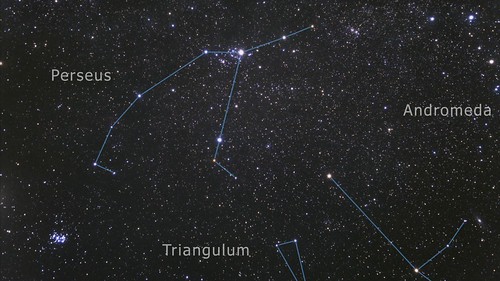Using Math to Map Constellations Deepens Sense of Place in the Universe
Using Math to Map Constellations Deepens Sense of Place in the Universe

Combining science, math, and even human history and culture, studies of stars and constellations is a community-based resource that’s accessible to everyone and a great nature-based way to integrate learning. Families can track changes in the night sky using basic math skills, and can deepen their sense of place within the universe by doing so.
In the first stanza of John Lennon’s wonderful song, Imagine, he sings “above us only sky.” While it is certainly true that above us is sky, it may not be fair to say that it is “only” sky. Looking at what’s above us is an accessible way to spark sky-based learning that connects to the development of skills in math, science, and even history and culture! In examining the night sky specifically, families can gain a greater sense of place within the universe, and a deeper experience-based understanding of the movement of the earth in relation to the expansiveness of outer space.
So if it’s not only sky above us, what is all of it? For young observers of the night sky, the obvious focal point of studying the sky is stars – the brightly glowing burning balls that seem to be an absolutely impossible distance from earth. Learning to identify constellations can help budding astronomers begin to learn how to get their bearings while looking at the night sky, and integrating studies of constellations with mapmaking guided by the coordinate plane can create opportunities to engage in meaningful hands-on learning filled with lots of careful work and critical thought.
Just as the earth spins around its axis once every 24 hours, it also makes a full rotation around the sun every year. So, we see the beautiful star-filled sky at night when our portion of the planet faces away from the sun, and the heavenly bodies we’re able to see in the night sky (and where exactly they’re located) change, too. Some stars and constellations remain above us all year round, even though their exact location in relation to where we live changes slightly. Other stars and constellations, however, disappear and reappear in a way that is roughly aligned with seasonal changes. Check out this list on Common Sense Media of astronomy apps you can download to use with your electronic devices for surveying the night sky.
So where do the constellations go when we can’t see them? And how far do the ones we can always see move, anyway? The answer to those questions lies at the intersection of astronomy and math.
By using a coordinate plane to map out landmark stars and constellations, families can track the changes in the night sky over time and identify places in the night sky where great discoveries are being made beyond the naked eye. The winter months are the best time to engage in such a project, as the stars are visible much earlier in the evening.
In order to track the change in stars’ positions over time, families will need graph paper – a whole notebook filled with 1-centimeter paper will work best. When making your first observation, choose a place to observe from that will be consistently accessible. Then, decide how to align what you see with the grid on the graph paper. It is best to have the top of the page aligned with the northern portion of the sky, but as long as you look in the same direction from the same place for each observation, changes in the sky will become obvious.
Once an observation point has been located, begin marking down the location of prominent stars and any constellations that you know. Each star should be marked on the intersection of two lines, and the lines connecting constellations can be filled in afterward. Repeat this every night (or most nights) for a few months in order to see the stars truly move across the sky – eventually, when compared with your first observation, new observations will make it very evident that something is moving.
Young astronomers who are able to work with the coordinate plane can add mathematical proof to their evidence of the changing night sky by assigning coordinates to the stars and/or constellations they’ve recorded and comparing the location of the coordinates in observations done at different times of the year. In addition, the distance that each star or constellation has moved (in terms of the coordinate plane sky map) can be determined by measuring in centimeters from the first point at which a star was found to the most recent point at which a star was found. But keep in mind – it’s not the stars that move, it’s the earth, and any change seen (or quantified) reflects changes in the earth’s position, not migrating constellations.
To deepen studies of the night sky, families can draw upon curriculum resources from a number of sources. Hilltown Families’ astronomy studies post highlights numerous ways to engage in star-inspired studies while utilizing community resources, and offers some tech-based resources and opportunities for citizen science, too. The University of Texas offers a lesson plan for the coordinate plane that includes points to plot in order to draw some commonly known constellations. Older astronomers who are also skilled at math and/or logic can tackle the Twinkle, Twinkle problem, which tackles a challenging mathematical concept within the context of stars and constellations. Finally, through the Smithsonian, the National Museum of African American History and Culture offers a lesson plan that links the graphing of constellations on the coordinate plane to their place within African history and culture, including their role within myths and creation stories.
For further support with observations of the night sky, try some of the titles listed below!
- Find the Constellations by H. A. Rey
- Glow-in-the-Dark Constellations by D. E. Thompson
- Zoo in the Sky by Jacqueline Mitton
- Wishing on a Star: Constellation Stories and Stagazing Activities for Kids by Fran Lee
- National Audubon Society Field Guide to the Night Sky by the National Audubon Society
- A Field Guide to the Stars and Planets by Jay M. Pasachoff and Roger Tory Peterson
- Nightwatch: A Practical Guide to Viewing the Universe by Terence Dickinson
[Photo credit: (cc) RubyT; Video credit: (cc) NASA Goddard Space Flight Center]
 Hilltown Families
Hilltown Families 






























